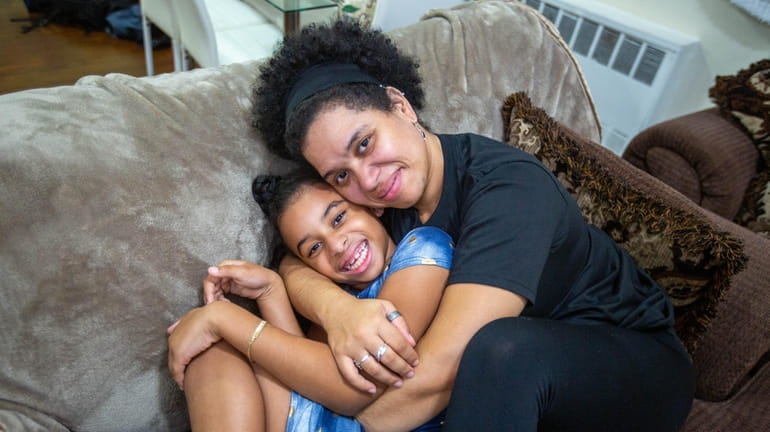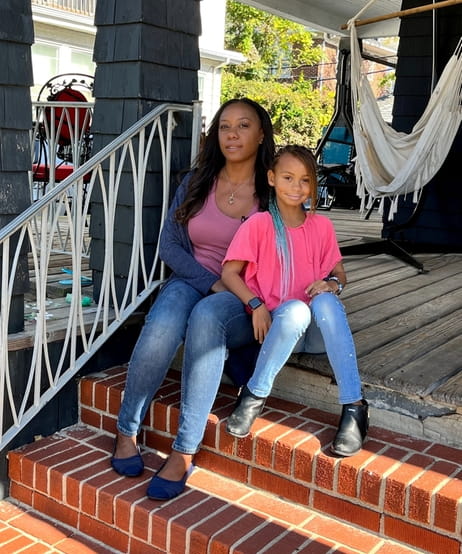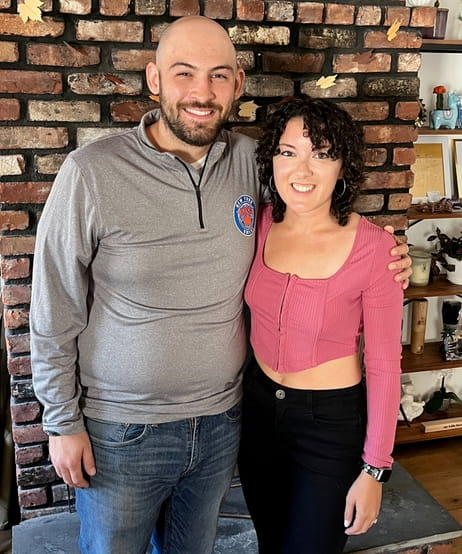Breast cancer rates among younger women rise while rates among older women fall

When Alexandra De La Rosa felt a lump in her breast while getting dressed in late 2020, she didn’t think it was cancer. After all, she was only 34.
“It never entered my mind that it could be cancer,” said De La Rosa, of Island Park. “The misconception we have about breast cancer is that it’s just older women after menopause.”
De La Rosa was diagnosed with breast cancer and had chemotherapy and a mastectomy. She’s in remission now.
Breast cancer is still much more common in older women than younger women. But while breast cancer rates among women 50 and older have fallen significantly in recent years, they’ve risen among women under 40, with thousands of cases diagnosed each year. And as death rates for older women continue to decline, they’ve either been level or may be increasing among young women.
Women 20 to 39 had a 4.1% increase in new breast cancer diagnoses between 1999 and 2018, while women 50 to 64 had a 13.7% decrease, according to a study published in January in the Centers for Disease Control and Prevention's Morbidity and Mortality Weekly Report.
Of the more than 264,000 female breast cancer diagnoses nationally in 2019, 4.4% were among women under 40, CDC data shows. Another 4.9% were in women 40 to 44. Twenty-four cases, or less than .01%, were in girls 15 to 19 years old.
“I often have [young] women come and say, ‘Why is this happening to me?’ And unfortunately we don’t have a cause and effect we can identify,” said Dr. Julia Brockway-Marchello, a medical oncologist and breast cancer specialist at Memorial Sloan Kettering Cancer Center in Uniondale. There could be environmental factors or genetic mutations that haven’t been discovered yet, she said.
There is an increasing incidence of other types of cancer among younger people as well, said Dr. Arif Kamal, chief patient officer of the American Cancer Society.
For breast cancer, risk is higher for women who have never been pregnant, and more women are having children at a later age or are not having them at all, he said. In addition, obesity rates have increased among younger women, and obesity increases risk, Kamal said.
The median age when a woman is diagnosed with breast cancer is 62, according to the cancer society.
Breast cancer death rates for women in all age groups had declined between 1989 and 2010, according to an analysis of federal data published in February 2021 in the journal Radiology. The rates continued falling for older women between 2010 and 2017 but stopped falling for women younger than 40.
The analysis showed an increase in death rates for young women, but the increase was within the margin of error, and it’s more likely that rates for young women have been relatively level, said Rebecca Siegel, a senior scientific director for the cancer society who was not involved with the study.
Breast cancer death rates in all age groups are highest among Black women, in part because Black women are less likely to get cutting-edge treatment after they’re diagnosed, Kamal said.
Dr. Shari Goldfarb, who cofounded Memorial Sloan Kettering’s Young Women with Breast Cancer program last year, said one reason death rates are not declining for young women is that they’re less likely to be screened for breast cancer than older women.
“When women are in their 20s or 30s, often their breast cancers aren’t detected until they’re large enough to feel,” Goldfarb said. “So it’s often at a later stage or a bigger tumor than if you were having a screening detecting breast cancer.”
The cancer society recommends breast cancer screenings for women beginning at age 40 or 45, but some higher-risk young women — including those with a family history of breast cancer — should begin receiving mammograms at age 25 or 30, Kamal said.
Others with a higher risk include women with genetic mutations, he said.
The two most common mutations are of the BRCA1 and BRCA2 genes. Between 45% and 72% of women with the mutations will develop breast cancer, according to the National Cancer Institute. Among the highest risk for the mutations are Ashkenazi Jews: 2% carry the mutation, compared with 0.2% to 0.3% of the U.S. population, cancer institute statistics show.
A large Ashkenazi Jewish population on Long Island could be one reason the Island has higher breast cancer rates than the state as a whole, said Dr. Brian O’Hea, chief of breast cancer surgery and director of the Carol M. Baldwin Breast Care Center at Stony Brook Medicine. Other demographic or environmental factors also could be reasons for the higher Long Island rates, he said. Studies have not found an environmental link, “But they haven’t proven it is or isn’t,” he said.
Nassau County has a breast cancer rate 10% higher than the state as a whole, and ranks fifth among New York counties, state Department of Health data from 2015 to 2019 shows. Suffolk has a rate 2.9% higher than the state’s.
Meagan Miraldi of Long Beach didn’t know she carried a BRCA mutation until after she was diagnosed with stage 3 breast cancer in December 2020, the day after she turned 29.
Like De La Rosa, she did not believe the lump she felt in her breast — in Miraldi's case, in August 2020 — was cancer. She knew several older women who had breast cancer, but she never met any women under 50 with the disease.
A sonogram of the lump showed it was benign, but in early November 2020, she felt another lump, in her armpit, and this led to another sonogram, a biopsy and the cancer diagnosis, Miraldi said.
Miraldi had chemotherapy to shrink the tumor, and then had a double mastectomy and breast reconstruction.
Lilith Costa, 39, of Rockaway Park, Queens, was tested for BRCA because of a history of breast cancer in her family, including of her grandmother’s sister, who died of it while in her 30s, and of her uncle, who is in remission. She tested positive and in 2017, at age 33, she had a prophylactic double mastectomy.
Costa said she chose the preventive surgery, which dramatically reduces but does not entirely eliminate the chance of developing breast cancer, because “the odds I was going to have cancer at a young age seemed likely. I thought I had to take action rather than waiting.”
Another option was regular screening, but “with screenings, it’s too late. You already have it. That’s why I did the prophylactic mastectomy.”
One complication of chemotherapy for women of childbearing age is that the treatment can cause temporary or permanent infertility. Miraldi had her eggs preserved as a precaution.
The young women program assists women in deciding whether to freeze eggs, which is a 10- to 14-day process that involves tests, medications, injections and surgery, she said.
Goldfarb said concerns about fertility are among the added stressors that younger women with breast cancer face.
“You’re diagnosed with cancer and now you’re being told you have to make a decision about doing an intense 10-day to two-week fertility process,” she said.
The decision must be made quickly, to not delay chemotherapy, Goldfarb said.
The program also helps women psychologically, Goldfarb said. Many younger women with breast cancer will have most of their lives ahead of them, and “we don’t want the cancer to define you,” she said.
Miraldi is in remission, but she has massage therapy for lymphedema, a sometimes painful swelling that is one of the most common side effects of cancer treatment. She also has muscular pain on her right breast because of radiation, and endures pain because of hip degeneration related to her chemotherapy.
“As a 30-year-old, you don’t think your hips are going to start degenerating,” she said.
Miraldi at first thought the hip pain could mean she had cancer in her hips. The fear of the cancer returning is always on her mind.
“Any slight pain I feel,” Miraldi said, “the first thought that comes is, ‘Could it possibly be a recurrence?’ ”
When Alexandra De La Rosa felt a lump in her breast while getting dressed in late 2020, she didn’t think it was cancer. After all, she was only 34.
“It never entered my mind that it could be cancer,” said De La Rosa, of Island Park. “The misconception we have about breast cancer is that it’s just older women after menopause.”
De La Rosa was diagnosed with breast cancer and had chemotherapy and a mastectomy. She’s in remission now.
Breast cancer is still much more common in older women than younger women. But while breast cancer rates among women 50 and older have fallen significantly in recent years, they’ve risen among women under 40, with thousands of cases diagnosed each year. And as death rates for older women continue to decline, they’ve either been level or may be increasing among young women.
WHAT TO KNOW
- Breast cancer rates among women 50 and older have fallen significantly in recent years, while they’ve risen among women under 40, according to a January study.
- Breast cancer is still much more common in older women than younger women.
- Nassau County has a breast cancer rate 10% higher than the state as a whole, while Suffolk has a rate 2.9% higher, according to state data.
Women 20 to 39 had a 4.1% increase in new breast cancer diagnoses between 1999 and 2018, while women 50 to 64 had a 13.7% decrease, according to a study published in January in the Centers for Disease Control and Prevention's Morbidity and Mortality Weekly Report.
Of the more than 264,000 female breast cancer diagnoses nationally in 2019, 4.4% were among women under 40, CDC data shows. Another 4.9% were in women 40 to 44. Twenty-four cases, or less than .01%, were in girls 15 to 19 years old.
“I often have [young] women come and say, ‘Why is this happening to me?’ And unfortunately we don’t have a cause and effect we can identify,” said Dr. Julia Brockway-Marchello, a medical oncologist and breast cancer specialist at Memorial Sloan Kettering Cancer Center in Uniondale. There could be environmental factors or genetic mutations that haven’t been discovered yet, she said.
There is an increasing incidence of other types of cancer among younger people as well, said Dr. Arif Kamal, chief patient officer of the American Cancer Society.
For breast cancer, risk is higher for women who have never been pregnant, and more women are having children at a later age or are not having them at all, he said. In addition, obesity rates have increased among younger women, and obesity increases risk, Kamal said.
The median age when a woman is diagnosed with breast cancer is 62, according to the cancer society.
Breast cancer death rates for women in all age groups had declined between 1989 and 2010, according to an analysis of federal data published in February 2021 in the journal Radiology. The rates continued falling for older women between 2010 and 2017 but stopped falling for women younger than 40.
The analysis showed an increase in death rates for young women, but the increase was within the margin of error, and it’s more likely that rates for young women have been relatively level, said Rebecca Siegel, a senior scientific director for the cancer society who was not involved with the study.
Rates highest among Black women
Breast cancer death rates in all age groups are highest among Black women, in part because Black women are less likely to get cutting-edge treatment after they’re diagnosed, Kamal said.
Dr. Shari Goldfarb, who cofounded Memorial Sloan Kettering’s Young Women with Breast Cancer program last year, said one reason death rates are not declining for young women is that they’re less likely to be screened for breast cancer than older women.
“When women are in their 20s or 30s, often their breast cancers aren’t detected until they’re large enough to feel,” Goldfarb said. “So it’s often at a later stage or a bigger tumor than if you were having a screening detecting breast cancer.”
The cancer society recommends breast cancer screenings for women beginning at age 40 or 45, but some higher-risk young women — including those with a family history of breast cancer — should begin receiving mammograms at age 25 or 30, Kamal said.
Others with a higher risk include women with genetic mutations, he said.
The two most common mutations are of the BRCA1 and BRCA2 genes. Between 45% and 72% of women with the mutations will develop breast cancer, according to the National Cancer Institute. Among the highest risk for the mutations are Ashkenazi Jews: 2% carry the mutation, compared with 0.2% to 0.3% of the U.S. population, cancer institute statistics show.
A large Ashkenazi Jewish population on Long Island could be one reason the Island has higher breast cancer rates than the state as a whole, said Dr. Brian O’Hea, chief of breast cancer surgery and director of the Carol M. Baldwin Breast Care Center at Stony Brook Medicine. Other demographic or environmental factors also could be reasons for the higher Long Island rates, he said. Studies have not found an environmental link, “But they haven’t proven it is or isn’t,” he said.
Nassau County has a breast cancer rate 10% higher than the state as a whole, and ranks fifth among New York counties, state Department of Health data from 2015 to 2019 shows. Suffolk has a rate 2.9% higher than the state’s.
Stage 3 cancer at 29
Meagan Miraldi of Long Beach didn’t know she carried a BRCA mutation until after she was diagnosed with stage 3 breast cancer in December 2020, the day after she turned 29.
Like De La Rosa, she did not believe the lump she felt in her breast — in Miraldi's case, in August 2020 — was cancer. She knew several older women who had breast cancer, but she never met any women under 50 with the disease.
A sonogram of the lump showed it was benign, but in early November 2020, she felt another lump, in her armpit, and this led to another sonogram, a biopsy and the cancer diagnosis, Miraldi said.
Miraldi had chemotherapy to shrink the tumor, and then had a double mastectomy and breast reconstruction.
Lilith Costa, 39, of Rockaway Park, Queens, was tested for BRCA because of a history of breast cancer in her family, including of her grandmother’s sister, who died of it while in her 30s, and of her uncle, who is in remission. She tested positive and in 2017, at age 33, she had a prophylactic double mastectomy.
Costa said she chose the preventive surgery, which dramatically reduces but does not entirely eliminate the chance of developing breast cancer, because “the odds I was going to have cancer at a young age seemed likely. I thought I had to take action rather than waiting.”

'The odds I was going to have cancer at a young age seemed likely. I thought I had to take action rather than waiting.'
-Lilith Costa, 39, of Rockaway Park
Credit: Shari Einhorn
Another option was regular screening, but “with screenings, it’s too late. You already have it. That’s why I did the prophylactic mastectomy.”
One complication of chemotherapy for women of childbearing age is that the treatment can cause temporary or permanent infertility. Miraldi had her eggs preserved as a precaution.
The young women program assists women in deciding whether to freeze eggs, which is a 10- to 14-day process that involves tests, medications, injections and surgery, she said.
Goldfarb said concerns about fertility are among the added stressors that younger women with breast cancer face.
“You’re diagnosed with cancer and now you’re being told you have to make a decision about doing an intense 10-day to two-week fertility process,” she said.
The decision must be made quickly, to not delay chemotherapy, Goldfarb said.
The program also helps women psychologically, Goldfarb said. Many younger women with breast cancer will have most of their lives ahead of them, and “we don’t want the cancer to define you,” she said.

'Any slight pain I feel, the first thought that comes is, ‘Could it possibly be a recurrence?’ '
-Meagan Miraldi,30, of Long Beach
Credit: Shari Einhorn
Miraldi is in remission, but she has massage therapy for lymphedema, a sometimes painful swelling that is one of the most common side effects of cancer treatment. She also has muscular pain on her right breast because of radiation, and endures pain because of hip degeneration related to her chemotherapy.
“As a 30-year-old, you don’t think your hips are going to start degenerating,” she said.
Miraldi at first thought the hip pain could mean she had cancer in her hips. The fear of the cancer returning is always on her mind.
“Any slight pain I feel,” Miraldi said, “the first thought that comes is, ‘Could it possibly be a recurrence?’ ”

Updated now Newsday travel writer Scott Vogel took the ferry over to Block Island for a weekend of fun.

Updated now Newsday travel writer Scott Vogel took the ferry over to Block Island for a weekend of fun.

